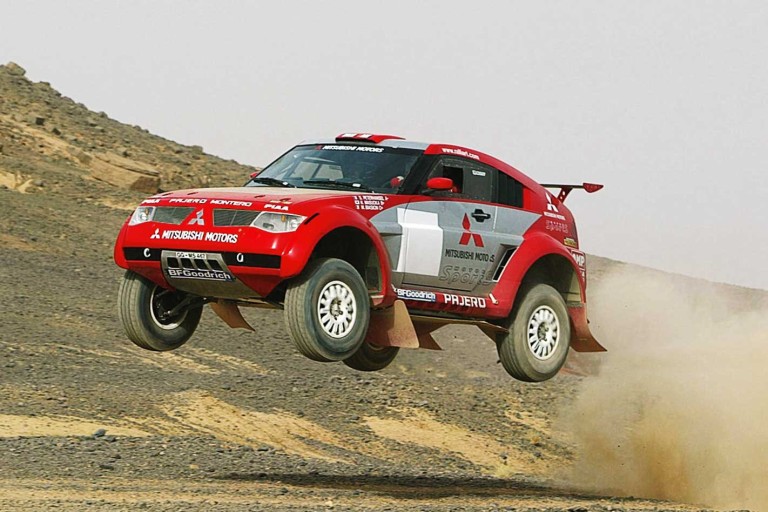
"Remember,” says Miki Biasion, “in this sport, the head is more important than the feet. When you become too confident in the car, it is easy to roll.”
This feature was originally published in MOTOR’s March 2004 issue
As if to illustrate the point, the Italian pauses to absorb the pain from the broken ribs sustained when he rolled his Mitsubishi Pajero Evolution on day two of the UAE Desert Challenge. “I thought I could jump a dune and I couldn’t,” he continues matter-of-factly. “You have to be correct and very careful.”

Thierry Viardot, the team’s technical director, ushers me into the passenger seat for a demo run. Everything inside the cabin is caked in a layer of desert dust and it has the acrid smell of stale sweat.
Despite the heat, this car has no air conditioning and the token side windows suck in sand instead of cool air. It’s difficult to imagine what it must be like to complete a 500km stage in this carbon fibre oven.
Viardot flicks a couple of toggle switches, prods a starter button and the 4.0-litre V6 grumbles to life. It’s based on the 3.5-litre road car unit but gains variable valve timing and modifications to the inlet and outlet ports. The power output is nothing to write home about at 201kW, but the engineers have concentrated on maximising the torque curve. The peak figure is a closely guarded secret, but Viardot admits that it’s “a lot”.
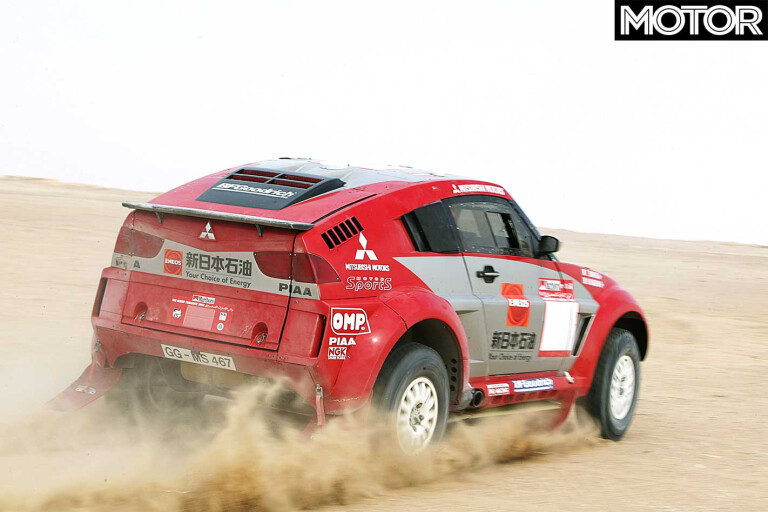
We complete a lap of the desert circuit and I’m struck by the Pajero’s civility. No racing car ought to ride this well. The way the Mitsubishi deals with the rocks and ruts that litter the desert landscape is exceptional. Mitsubishi should employ Viardot to sort the suspension of the road-going Pajero.
The technical director pulls to a stop and we swap places. It’s a nervous moment, but not for the reasons you’d expect. This car has been tailored to Biasion’s diminutive frame; it was never intended to accommodate 6ft 3in of gangly Pom. By the time I’ve levered my crotch behind the steering wheel, my legs are pinned to the facia in a way that will make any sort of yump excruciatingly painful. Chief engineer Bernard Lindauer looks at me disapprovingly. “Just be careful,” he says, and shuts the door.
I’d spent some time earlier in the morning discussing the technique with Mitsubishi’s lead driver, Stephane Peterhansel.
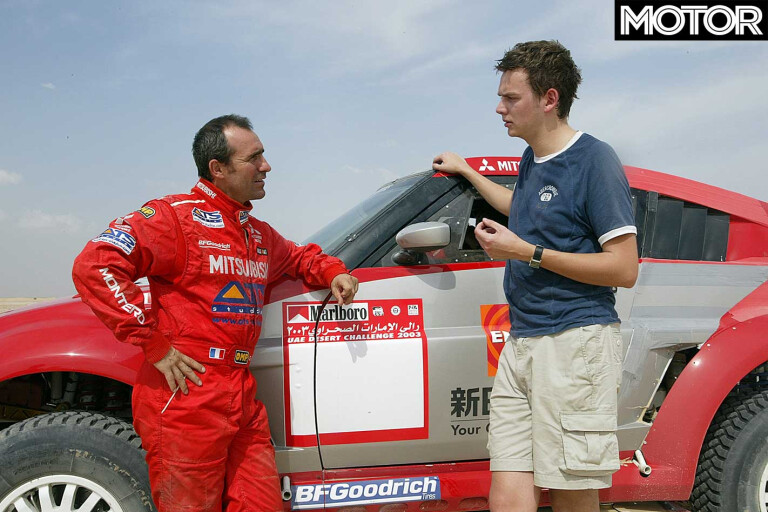
“The gearbox is sequential,” he explained, “and you don’t need to use the clutch. You put your right foot on the throttle and your left on the brake. That way you can use both feet to balance the car through high-speed corners.”
According to Peterhansel, the biggest difference between a rally raid challenger and a World Rally Car is the centre of gravity. “This is a big car, on big suspension and with a fuel tank capacity of 500 litres. When you turn, you must be careful because it’s easier to roll than a WRC,” he continued.
The other major difference, of course, is the absence of pace notes. The rally raid route directions appear on a roll of what looks like bog paper. They describe the desired trajectory, but offer no clue as to the nature of the corner.
“You are driving for many thousands of kilometres without a recce, so you have to find a pace where you can read the road and not be harmed by unexpected terrain, such as a jump,” said operations manager Bernard Lindauer, who used to work on Mitsubishi’s WRC program.

This view was echoed by Carlos Sousa, the newly crowned FIA World Cup for Cross Country Rallies drivers’ champion.
“I’m not the fastest driver in the team,” he said modestly, “but this is not important in a 20 or 22-day race, because if you were flat out all the time, something would happen. I don’t believe that the driver who wins the most stages will win the Dakar.”
Concentration is another key to success. “Endurance is very important,” continued Sousa. “It’s almost impossible to be concentrated 100 percent for all the hours and all the kilometres.”
.jpg )
Peterhansel interjected: “It’s probably the hardest part of the sport; you don’t know the road and African rallies are very dangerous.”
Enough of the theory. I jab the starter button and pull once on the gearstick to engage first. Then I depress the clutch and dial up a few thousand revs. The loud pedal isn’t super-sensitive like it is on a track car and the carbon clutch is super-easy to use; you don’t need the delicacy of a ballet dancer to effect a smooth getaway.
I describe an oval in second gear to acclimatise myself with the controls. The Evolution is not quick. With a full tank of fuel and four spare tyres it weighs 1825kg, so the weight-to-power ratio is a none-to-startling 9.08kg/kW – little better than a Ford Focus ST170. Top speed is just 205km/h, although this is a 10km/h improvement on earlier Evolutions.

The gearchange, though, is brilliant. You just lift off the throttle, jab the gearstick and the hydraulic system selects the next ratio with a satisfying clunk. The power-assisted rack and pinion steering is also pleasantly weighted and far from nervous. It all adds up to a car that is remarkably easy to drive.
There is a crackle in my headphones: “Head for the dunes,” says Viardot. These are one of the trademark features of desert racing and crossing them successfully calls for patience and experience.
Sousa explained his strategy: “Some drivers tackle them at speed, but if you do that you take a risk on the other side. I prefer to cross the dunes using the torque. That way, I have the possibility to change direction at the top.”

Even this technique can be fraught with danger and, blessed with zero experience, I opt for the torque technique and summon second gear as we enter the soft sand at a moderate pace. It is here that the Xtrac self-locking differentials work their magic. Traction is impressive and the mountainous torque hauls the Evolution over the crests.
The descents are no less impressive. Regulations limit suspension travel to 250mm, but the combination of eight shock absorbers and excellent approach and departure angles help it to scale the most difficult terrain.
The road opens up once more and I accelerate hard, reaching 150km/h in the fifth of six gears. At such speeds, the experience feels almost otherworldly. The high-set driving position and suspension compliance create the impression that you’re aloof from the action. The sensation is not dissimilar to that of a high-speed catamaran.
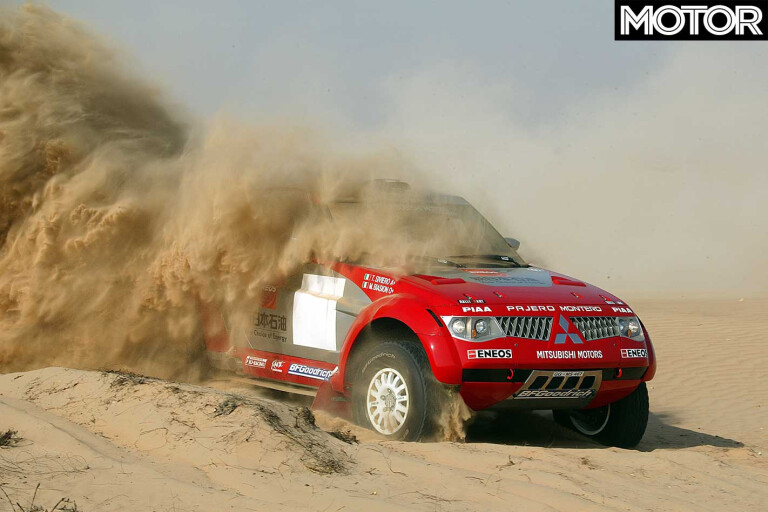
I dab the brakes, turn and deliberately stab the throttle in a bid to unsettle the rear. I’m anticipating a generous power slide, but the Evolution is coaxed into nothing more than a gentle four-wheel drift.
Biasion is right: it would be easy to become overconfident in this car and Viardot tempers my enthusiasm with some words of caution.
“Stick to the track,” he urges. “It’s almost impossible to spot the holes in the desert that could cause a roll.” A few turns more and we return to our makeshift paddock. My knees are bruised and battered but my grin is larger than ever.
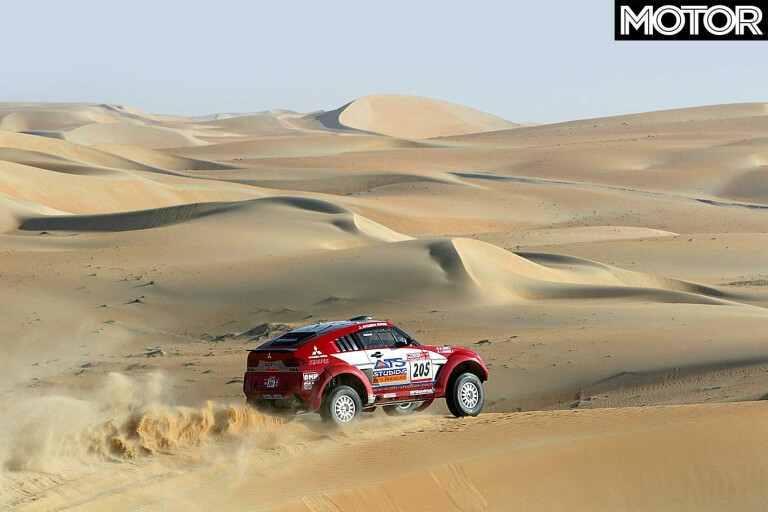
Lindau reckons an engineer can get just as much satisfaction out of rally raiding as out of the WRC, and Biasion believes that the desert challenges “invoke the spirit of rallying as it used to be”.
Both have clearly been charmed by their adopted sport, and it’s not difficult to see why. The Pajero Evolution rally raid car is attractive, exciting and thoroughly desirable. If only Mitsubishi could inject some of this spirit into its road cars.
FAST FACTS
2004 Mitsubishi Pajero Evolution
BODY: 3-door buggy
DRIVE: all-wheel
ENGINE: front-mounted 4.0-litre DOHC 24-valve V6
POWER: 201kW @ 6000rpm
TORQUE: N/A
BORE/STROKE: 99.0mm x 92.0mm
COMPRESSION RATIO: 10.0:1
WEIGHT: 1825kg
POWER-TO-WEIGHT: 110kW/tonne
TRANSMISSION: 6-speed sequential manual
SUSPENSION: double wishbones, coil springs, anti-roll bar (f); double wishbones, coil springs, anti-roll bar (r)
L/W: 4445/1978mm
WHEELBASE: 2725mm
TRACKS: 1750mm (f); 1736mm (r)
BRAKES: Brembo ventilated discs, six-piston calipers (f); Brembo ventilated discs, six-piston calipers (r)
WHEELS: 16 x 7.0-inch (f & r), magnesium
TYRES: BF Goodrich, 235/85 R16 (f & r)
FUEL: 500 litres, PULP
PRICE: how big’s your budget?
Five Reasons why Peterhansel is God
- He’s won the Dakar six times on a bike. Six times!
- He was world enduro champion in 1997
- He was robbed of Dakar victory last year – on the penultimate stage!
- In the off-season he dabbles in French ice racing
- He won Dakar this year despite being penalised five minutes for getting a push
Five Facts about Senegal and Dakar
- Lingo is French, church is Islam
- Birth rate 36/1000 people (Australia 12)
- Life expectancy 56.4 years (Australia 80.13)
- Infant deaths 61.3/1000 (Australia 4.83)
- 5% GDP growth/year from ‘95 to ‘03
Pressure's On
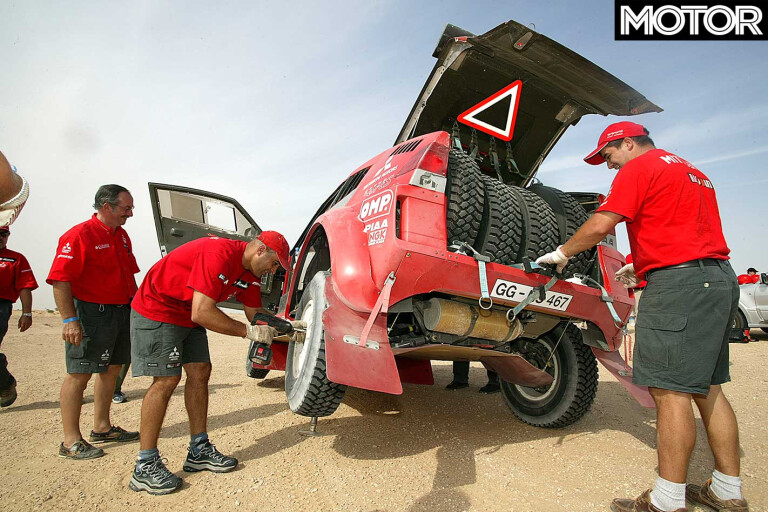
The Pajero Evolution is fitted with a TPC (Tyre Pressure Control) system. Developed in-house by Mitsubishi, TPC allows the driver or co-driver to adjust the pressure of the BF Goodrich tyres from inside the cockpit at racing speeds.
An on-board compressor feeds a supply line that is connected to the tyres’ external valves. In soft sand, for example, the driver will reduce the pressure in order to increase traction, before increasing it again on firmer ground.
Scot of the desert

Not surprisingly, Mitsubishi’s drivers had some pre-Dakar advice for Nissan’s Navara-driving raid virgin Colin McRae. “For sure he will be fast,” reckoned Sousa, “but you need experience to cope with the sand dunes and the navigation.” Peterhansel concurred: “He’s got the car control but you have to be consistent. In WRC you are always at the maximum, but if you do that in rally raid, you will crash. He would be better to take a few months of holiday than to go to an African rally.”
Typically, McRae did the exact opposite. The 1995 world rally champion took his time, fighting back after being stranded in the desert with transmission problems to win the 475km Ayoun el Atrous stage and finish 20th overall. Without crashing!

COMMENTS